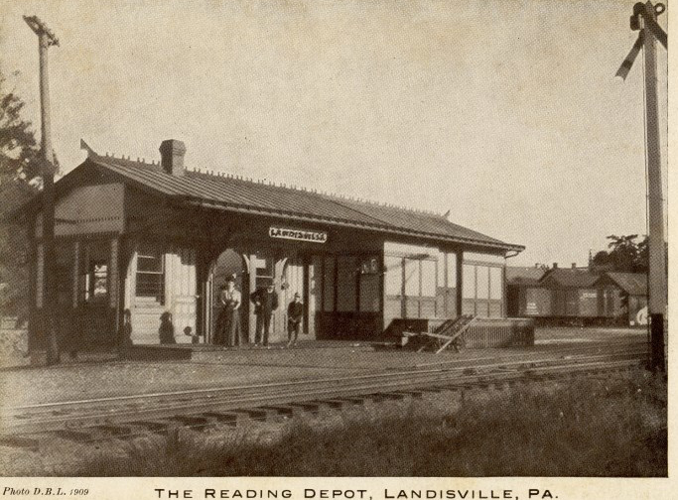Towns established
Established in 1790, the Mennonite Meeting House, which can still be seen near Church Street and Camp Meeting Road in Landisville, was one of the first buildings in the area.
In 1798, Jacob Minnich built a residence east of the church and also opened the Sycamore Inn, later the Landisville Hotel, and now Black Knight Tavern.
By the middle of the 1800s, the eastern end of Landisville was home to a variety of tradespeople, including a wagon-maker, blacksmith and a cigar-maker, who processed tobacco from the surrounding countryside.
To the west, the first structure in Salunga was built around 1760. Jacob Hostetter, a farmer who became wealthy through manufacturing “Dr. J. Hostetter’s Celebrated Stomach Bitters,” laid out building lots in 1847.
Sports complex

Archers lined up for competition during the Lancaster Archery Classic at Spooky Nook Sports Complex in January 2019.
The Hiestands were one of the early families in the area that would become Salunga, owning a farm just north of the current Route 283 that was part of an original land grant from William Penn.
Members of the Hiestand family operated a general store in Salunga and also owned a grain and feed mill that was struck by fire in 1910, an event that prompted the formation of Salunga’s first fire company.
Part of the Hiestand farm property was eventually bought by Armstrong Cork, a forerunner of Armstrong World Industries, which in 1975 announced plans to build a 600,000-square-foot warehouse and distribution center on a 135-acre tract.
As it was working through a bankruptcy in 2006, Armstrong sold the massive building to Spooky Nook Sports, which opened a $26 million sports complex in 2013. Spooky Nook, which is home to the U.S. women’s field hockey team, is the largest indoor sports complex in the nation. It was developed by Sam Beiler, a former owner of Auntie Anne’s soft pretzels.
The Hiestand family cemetery, which includes marker stones that date to the early 1700s, can still be seen just east of the parking lot access road.
Camp meeting established

Cabins are pictured through a gazebo at the Camp Meeting facility in Landisville on Tuesday, October 8, 2019.
As part of the wave of religious outdoor meetings at the time, Methodists held some camp meetings in Manheim in 1867, followed by well-attended gatherings the next two years.
Looking for a permanent spot to hold their annual revival meetings, Methodists chose a 24-acre spot outside of Landisville, citing easy access to clean water, the nearby railroad station as well as “the beauty of the tall oaks, chestnut and hickory (trees) on the grounds,” according to a camp history.
In the 1870s, camp meetings and religious programs were held there, with thousands of people attending from cities such as New York, Philadelphia and Baltimore. People traveled by train and set up tents and camped on the grounds.
In the late 1800s, cottages were built around a central courtyard. There are now 56 cottages and the present tabernacle, which seats about 1,000 people, was built in 1907.
Somewhere between 1960 and 1970, the Methodist Church withdrew direct sponsorship of the campground, and the property continues to be owned by the Landisville Camp Meeting Association, which has 85 members.
As per a long-standing arrangement with East Hempfield Township, the water is shut off from Nov. 1 to April 1, with a caretaker’s cottage being the only building that can be occupied year-round.
Bypass opens
For most of their history, Landisville and Salunga were key stops on transportation networks through the area.
The towns grew up along a circa-1805 road known as the King’s Highway, now Harrisburg Pike, that ran between Lancaster and Middletown. Historic stone mileage markers for the early turnpike can still be seen along the road near Amos Herr and the Hempfield Fire Department parks.
Salunga and Landisville were also served by the Pennsylvania Railroad, which opened in 1834, as well as a trolley service that ran between Lancaster and Elizabethtown.
While Landisville and Salunga are still situated near key transportation hubs, the 1949 opening of the Harrisburg Pike bypass, now Route 283, means most travelers don’t come directly through town, and the area has became more of bedroom community.
Skirting the edge of the towns with an interchange west of Salunga, Route 283 also created a barrier that funneled subsequent development to the south. With the exception of Spooky Nook Sports, areas north of Route 283 are still farmland.
School center grows in Landisville

Students exit buses outside Hempfield High School for the first day of classes in 2017.
While early schools were built in the area of Landisville and Salunga, the 1955 opening of a new Hempfield Joint High School centralized schools for Mountville Borough and East and West Hempfield townships.
The building, which forms the core of the current high school, was built to accommodate 1,000 students. But it was also constructed with “modular coordination,” which made building additions easier by using construction materials made in multiples of 4 inches.
Today, the high school has 2,200 students and is part of a complex where 3,800 other students attend the district’s intermediate, primary and middle schools.








 CHAD UMBLE | Staff Writer
CHAD UMBLE | Staff Writer

